Structuring blueprints
With blueprints you can create highly customized layouts that display the perfect interface for any type of data.
Only fields
The most simple setup of a blueprint is a form with just a few fields. For this setup, you can add fields using the fields keyword, then add your fields underneath with proper indentation:
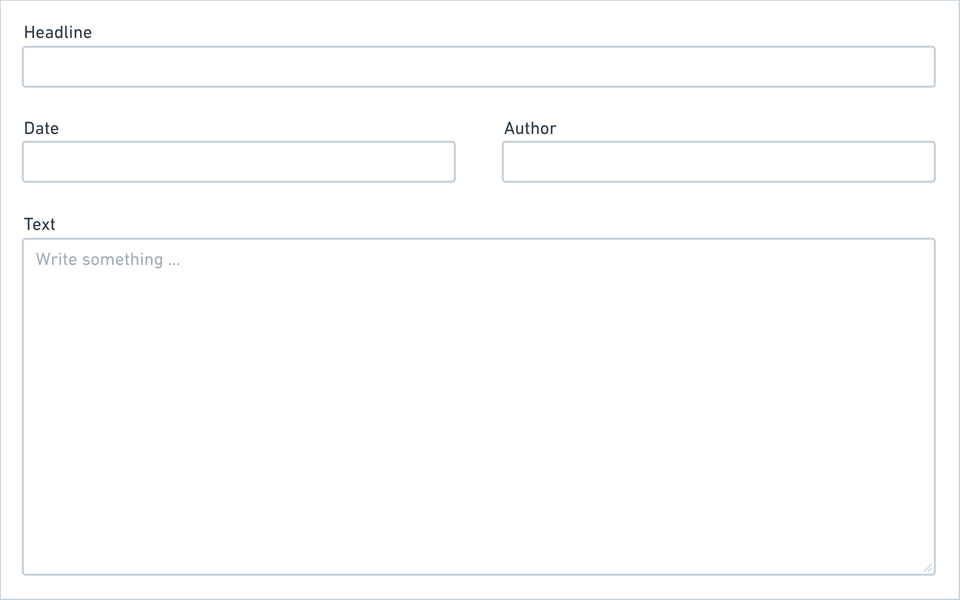
title: My blueprint
fields:
headline:
label: Headline
type: text
text:
label: Text
type: textareaFor more sophisticated setups, you can use sections, columns and tabs to create nice layouts.
The fields keyword can be used on the top blueprint level like in the example above, but also in columns or tabs. However, once you want to mix sections and fields inside the same blueprint, column or tab, you need to wrap your fields inside a fields section. See examples below.
Sections
With the sections keyword you add one or more section types to your blueprint. When the sections keyword is used without being wrapped in columns, this will result in a single-column layout of stacked sections.
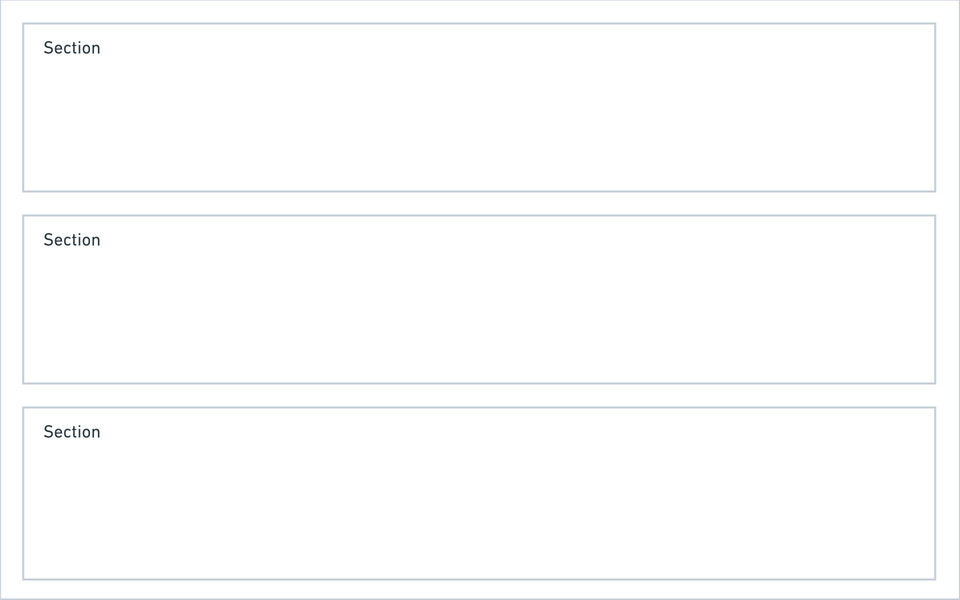
Here are some examples:
In this example we use multiple pages sections to separate drafts from published pages:
title: My blueprint
sections: # keyword that allows you to add multiple section types
drafts:
type: pages
label: Drafts
status: draft
published:
type: pages
label: Published pages
status: listedIn this example we have a pages section and a files section below each other
title: My blueprint
sections:
pages:
type: pages
label: Pages
files:
type: files
label: FilesYou always need to create sections when you want to mix any type of section with fields. In that case, your fields need to be wrapped in a fields section
title: My blueprint
sections:
pages:
type: pages
label: Pages
fields:
type: fields
fields:
text:
type: text
description:
type: textColumns
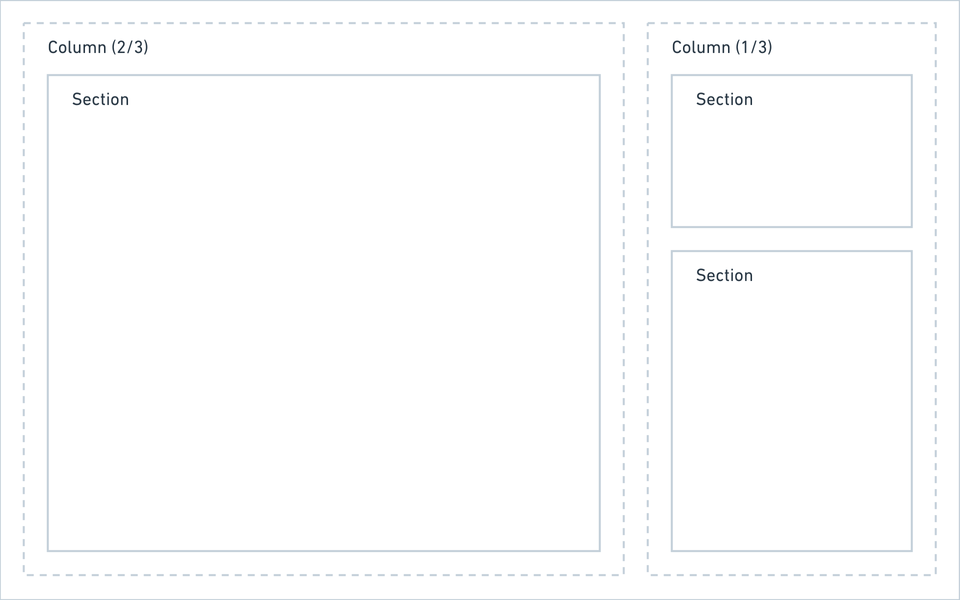
A single-column stacked layout like the above with only sections can sometimes be useful, in many cases you will, however, want to give more structure to your layout. That's where columns come into play.
A column can hold only fields, or different section types, the same rules for mixing fields and section apply as already outlined above.
Defining columns
Column definitions start with the columns keyword, followed by the individual column definitions. Columns can be defined in two ways:
title: My blueprint
columns:
left:
width: 2/3
sections:
# fields in the left column
right:
width: 1/3
sections:
# sections in the right columnYou have to use named columns if you want to extend columns.
title: My blueprint
columns:
- width: 2/3
fields:
# fields in the left column
- width: 1/3
sections:
# sections in the right columnThe following widths are available when defining columns:
1/2, 1/3, 1/4, 2/3, 2/4, 3/4
Adding fields and sections to columns
Just like a blueprint itself, a column can contain fields only:
title: My blueprint
columns:
- width: 2/3
fields:
subtitle:
type: text
blocks:
type: blocks
- width: 1/3
fields:
published:
type: date
author:
type: users
max: 1You can also add sections to a column. If you want to mix fields with sections inside a single column, sections are mandatory.
title: My blueprint
columns:
# main
main:
width: 2/3
sections:
# a simple form
content:
type: fields
fields:
headline:
label: Headline
type: text
text:
label: Text
type: textarea
# sidebar
sidebar:
width: 1/3
sections:
# a list of subpages
pages:
type: pages
label: Subpages
# a list of files
files:
type: files
label: Files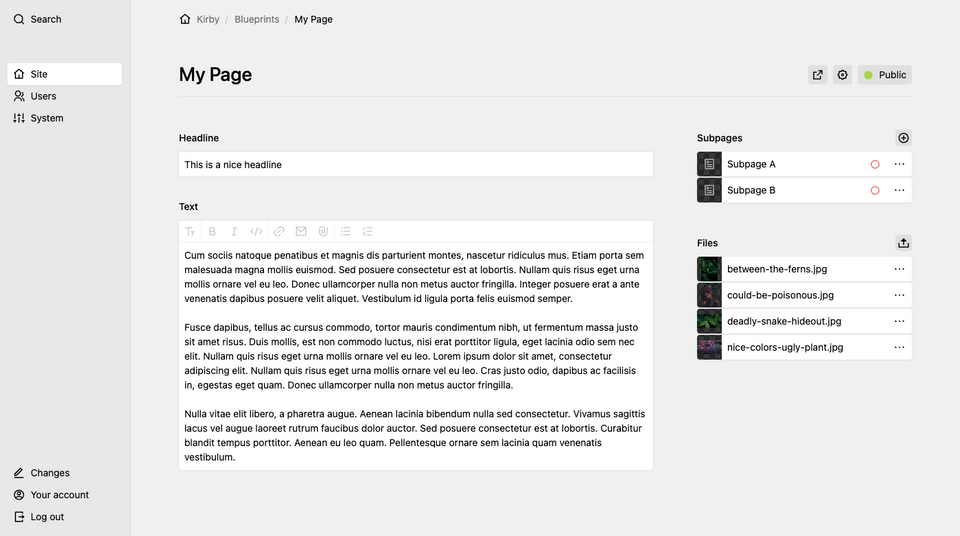
You can probably already see how flexible this is. By slightly changing the columns, we can change the interface drastically.
Sidebar on the left
title: My blueprint
columns:
# sidebar
sidebar:
width: 1/3
sections:
# a list of subpages
pages:
type: pages
label: Subpages
# a list of files
files:
type: files
label: Files
# main
main:
width: 2/3
fields:
headline:
label: Headline
type: text
text:
label: Text
type: textarea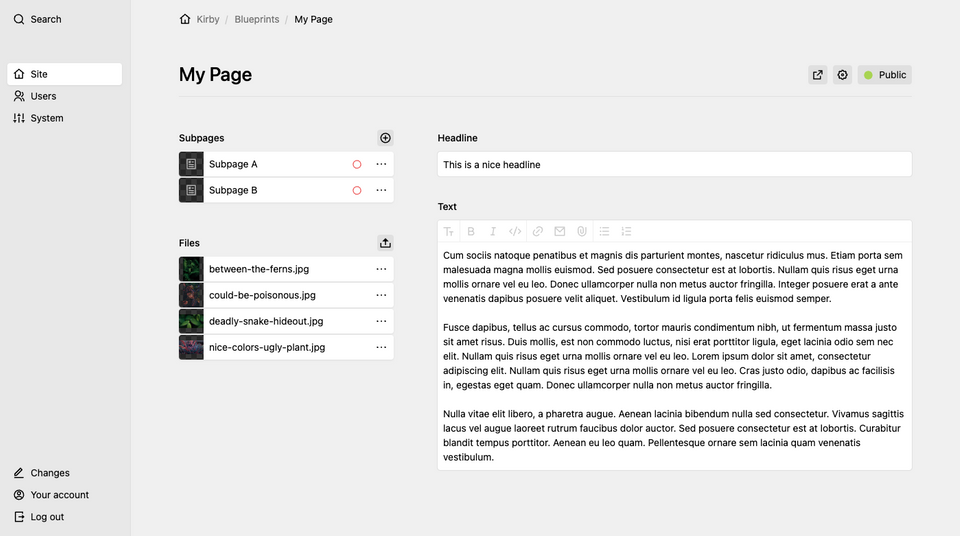
Two Sidebars
title: My blueprint
columns:
# sidebar left
left:
width: 1/4
sections:
# a list of subpages
pages:
type: pages
label: Subpages
template: default
# main
main:
width: 1/2
sections:
# a simple form
content:
type: fields
fields:
headline:
label: Headline
type: text
text:
label: Text
type: textarea
# sidebar right
right:
width: 1/4
sections:
# a list of files
files:
type: files
label: Files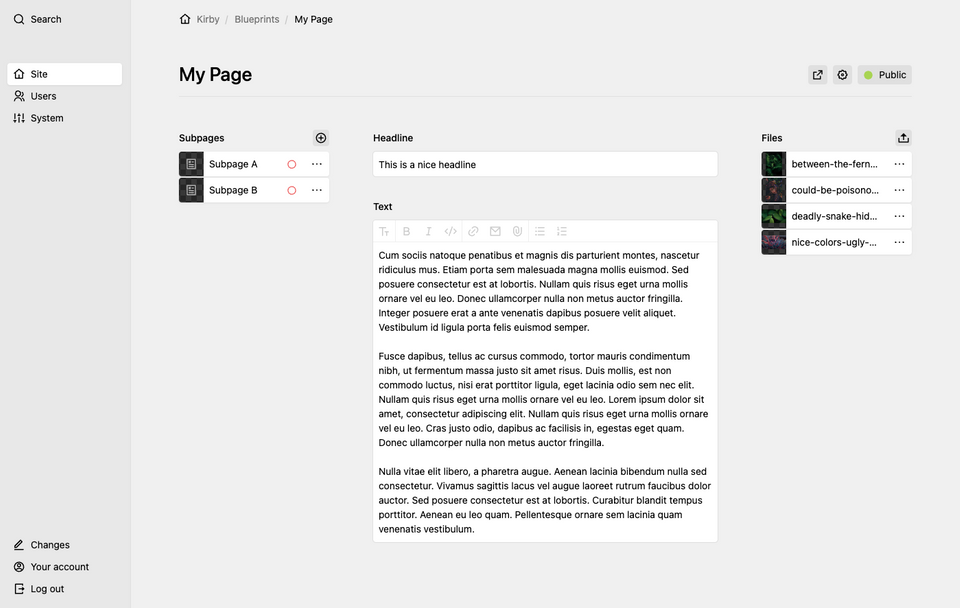
Sticky columns
You can make an entire column sticky. This can be handy for a setup with a smaller sidebar that should always be available, even when you scroll.
columns:
- width: 1/3
sticky: true
sections:
# sections in the sticky columnAdapt all to your needs
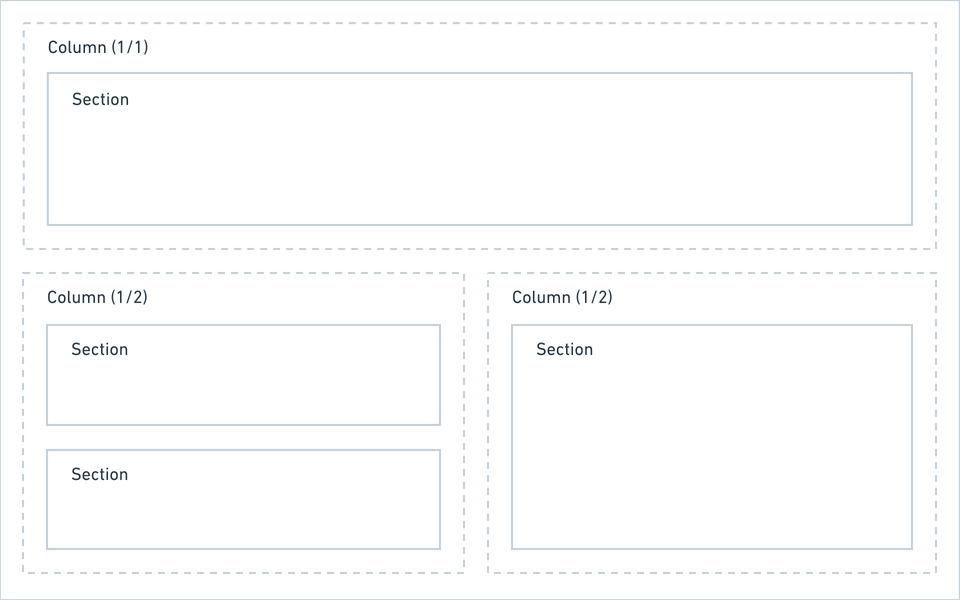
Kirby gives you the flexibility to set up the Panel so that it adapts to the needs of every single page/template. Use the layout possibilities to create the structure that works best for you:
title: My blueprint
columns:
gallery:
width: 1/1
sections:
gallery:
type: files
layout: card
...
review:
width: 1/2
sections:
drafts:
type: pages
status: draft
...
review:
type: pages
status: unlisted
...
published:
width: 1/2
sections:
published:
type: pages
status: listed
...If this isn't yet enough ways and space for you to structure your sections and fields, move on with…
Tabs
When your blueprints get more complex, splitting up your view into multiple tabs helps to keep them organized. Tabs are basically wrappers around regular blueprint layouts. Check out how to create layouts before you get started with tabs.
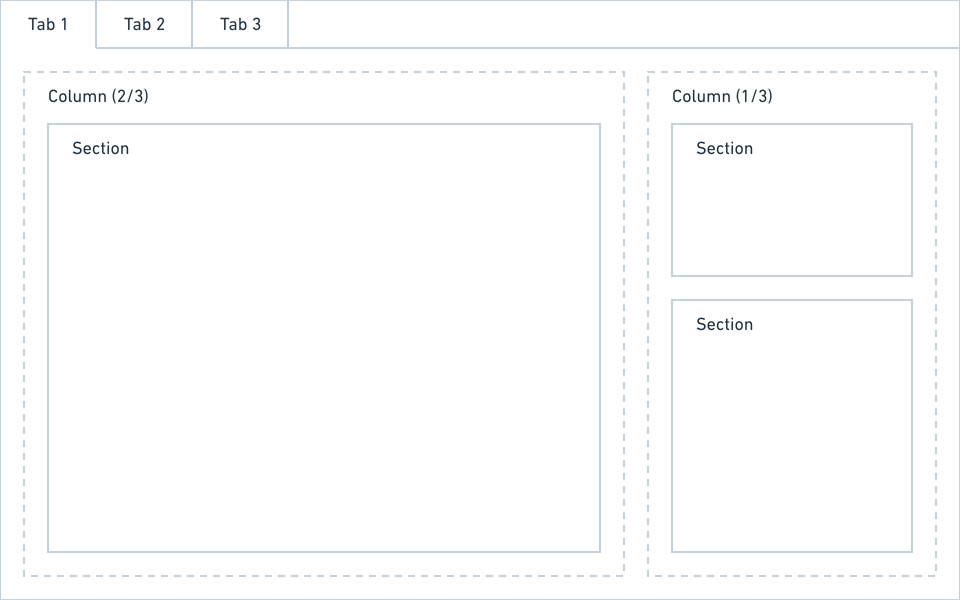
Like the blueprint itself, a tab can contain
- only fields
- one or more sections
- columns with fields and section
Defining tabs
A tab definition has three options:
- label
- columns
- icon
The icon is optional. Please check out the list of available icons. You can also use an emoji by pasting it directly into the blueprint.
title: My blueprint
tabs:
content:
label: Content
icon: text
columns:
# layout
seo:
label: SEO
icon: search
columns:
# layout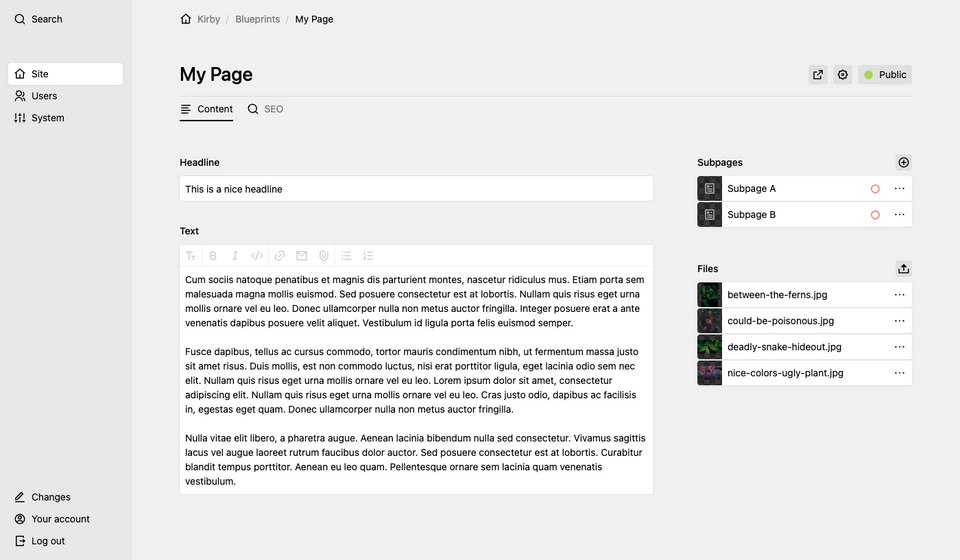
Full example
title: My blueprint
tabs:
# content tab
content:
label: Content
icon: text
columns:
# main
main:
width: 2/3
sections:
# a simple form
content:
type: fields
fields:
headline:
label: Headline
type: text
text:
label: Text
type: textarea
# sidebar
sidebar:
width: 1/3
sections:
# a list of subpages
pages:
type: pages
label: Subpages
# a list of files
files:
type: files
label: Files
# seo tab
seo:
label: SEO
icon: search
fields:
seoTitle:
label: SEO Title
type: text
seoDescription:
label: SEO Description
type: text